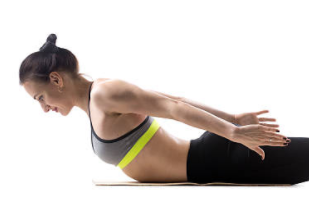The dorsal raise, also known as the prone back extension, is a simple and basic but highly effective lower back strengthening exercise that can be done anywhere.
The dorsal raise also targets your inner core and gluteal region, helping improve your posture and your posterior chain.
Table of contents
- Classification and muscles used
- How to perform
- Common mistakes
- Progression and regression
- Variations
- Closing thoughts
Classification and muscles used
- Type: Bodyweight
- Action: Extension
- Plane: Sagittal
- Erector spinae
- Multifidus (inner core)
- Quadratus lumborum (inner core)
- Gluteus maximus (buttocks)
- Transverse abdominus
- Pelvic floor
- Gluteus medius and minimus
- Rectus abdominus (abs)
How to perform
The basic dorsal raise back extension. Photo from Premier Sportsplex.
- Lie face down on the floor or exercise mat.
- Place your hands by your ears with elbows out to the side parallel to the floor.
- Brace your core.
- Breathe in and then breathe out as you extend your back by raising your chest and arms off the floor whilst engaging your glutes.
- Ensure you keep your head and upper back straight in alignment as well as keeping your hips and legs on the floor.
- Do not overextend your back. You do not need to raise up as far as possible. If done correctly you will feel it in your lower back muscles before over-extension.
- Hold position for desired time and then lower back down in a controlled manner, breathing in whilst doing so.
- Repeat for desired repetitions and keep your breathing rhythmic.
Common mistakes
With an exercise so simple and basic there are not too many mistakes that can happen. However the following tend to occur:
- Over-extending your back. This puts stress on your lower spine.
- Under-extending. Fails to adequately target your back muscles.
- Arching the neck backwards or forwards.The neck and head should be in line with your upper body to maintain proper alignment.
- Jerking your shoulders or upper back to create momentum to perform a rep. The movement should be performed by the lower back and glutes.
- You hold your breath.
Progression and regression
Ways to regress, or to make this exercise easier to perform:
Arms on the ground supported dorsal raise. Photo from To Your Health.
- Place your hands and arms by your sides on the floor rather than out at your head. This reduces the weight load up at the end of the chain at your head.
- Place and keep your hands on the floor to reduce the weight bearing load of the upper body.
- Use a back extension machine to stabilise your body and take most of your weight.
To make the dorsal raise harder:
- Put your hands/arms out in front of your head to increase the leverage and thus weight at the end of the chain.
- Raise your feet and legs off the ground at the same time as you extend your back creating a mild arc in your body. This is also known as the Superman.
- Place a balance disc underneath your waist/hips instead of lying flat on the floor. This makes this exercise extremely harder by targeting your proprioception.
Variations
Below is a list of some of the many variations of the dorsal raise that can be done:
- Dart: Performed with your hands and arms by your side. As easier variation, where you focus on reaching back with your arms. This is different from simply having your arms by your side as you raise your arms keeping them parallel to the floor at the same time throughout.
Dart variation of the dorsal raise back extension. Note the hands are also lifted of the floor. Photo from Wrightstown Chiropractic and Rehabilitation.
- Alternating raises: Similar to alternating sit-ups where you raise your body to one side and then in the next rep to the other side. Targets that specific side harder as it has to do more work to bring the body up than the other side.
- Supermans: With your arms raised up and out in front of you and your legs likewise raised up as if you're flying like Superman.
Superman variation of the dorsal raise back extension. Photo from Adore The Life.
- Swiss ball dorsal raises: The use of a Swiss ball instantly makes this exercise a lot harder by challenging your ability to maintain balance whilst performing reps.
- Back extension machine: Allows you to add weight to make the exercise harder. Limits your range however and has you locked into place taking away any synergistic effect on the rest of the body.
- Roman Chair/Glute Ham Developer: Two great pieces of equipment that allow you to bring your body lower into an inverted situp position meaning you can target the back muscles far harder and with a greater range of motion than you can lying on the floor. If you see these in a gym make use of them!
Closing thoughts
A good staple exercise for developing stronger lower back muscles, the dorsal raise is often overlooked in favour of the back extension machine to which you can add weight to. Yet unlike the machine version it can be done anywhere at any time with no equipment.
For more core exercises check out the Exercise Library Core section. Until then if you have any questions feel free to comment below or send me some feedback!
Lyle Richardson,
Gym Pal - Your friend in the world of fitness








0 comments:
Post a Comment